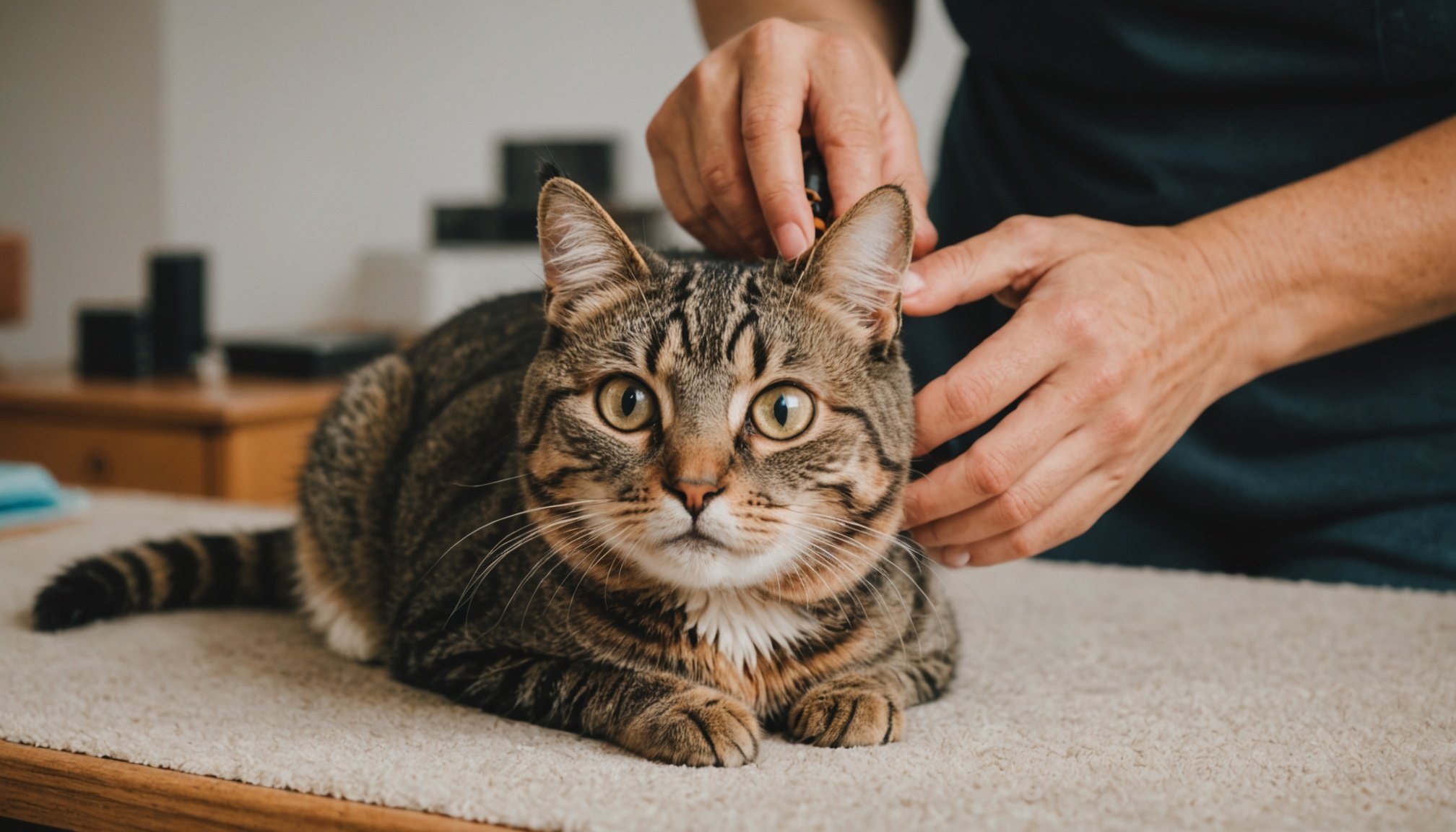Understanding Your Cat’s Behavior
Grasping cat behavior can often be a puzzle, yet it is crucial for maintaining a harmonious relationship with your feline companion. Recognizing signs of stress in cats is the first step toward creating comfort.
When a cat feels feline anxiety, it may display stress signals such as crouching low, tail flicking, dilated pupils, or flattened ears. These behaviors often indicate discomfort, especially during activities like nail trimming. Interpreting these signals allows owners to adapt the environment or approach, leading to a less stressful experience for the cat.
Also to see : Transform your cat”s nighttime routine: effective tips for aligning their sleep schedule with your lifestyle
Creating a calm atmosphere is paramount. Cats thrive in stable, tranquil settings, and sudden changes such as loud noises or abrupt movements can heighten their stress. Ensuring a peaceful ambiance can significantly ease anxiety, promoting relaxation for both routine grooming and well-being.
Pay attention to body language during nail trimming sessions. A relaxed cat will typically have a neutral tail position and normal pupils. Conversely, signs of distress require immediate attention to prevent escalation. It might be beneficial to take breaks or use gentle tones to reassure your pet. Understanding these subtle cues will help you better cater to your cat’s needs.
Also to see : Ease your cat”s worries: proven tips for overcoming feline separation anxiety
Preparing for Nail Trimming
Preparing effectively for nail trimming ensures a smooth experience for both you and your cat. Selecting the right tools is paramount. Opt for clippers specifically designed for cats to ensure precise and safe trimming. These tools typically have a unique shape to accommodate a cat’s claws better than human clippers, reducing the risk of injury.
Creating a safe and comfortable space is crucial. Designate a quiet area where your cat feels at ease. Remove any distractions to keep their anxiety levels low. This space becomes your cat’s designated grooming spot, associating it with positive experiences over time.
Cat calming techniques are beneficial during this process. Spending time petting your cat and talking soothingly can appear reassuring. Calming aids such as pheromone sprays or diffusers may also facilitate the process, helping your feline friend remain relaxed.
Getting your cat accustomed to having its paws touched is pivotal in preparation. Regularly handle their paws gently, offering treats as a reward. This conditioning builds trust, making the actual nail trimming less stressful. Starting young increases acceptance, but older cats can adapt with patience and consistency, making the task manageable.
Techniques for Calming Your Cat
Navigating the diverse solutions available for cat safety should be seamless, even when trimming your feline friend’s claws. Discovering effective calming techniques can be crucial in ensuring a harmonious experience for both you and your pet.
Gentle Restraint Strategies
In situations demanding gentle handling, employing soft, reassuring holds can significantly ease a cat’s anxiety. This technique centres on providing physical support to your cat without exerting unnecessary pressure. Imagine a gently cradling hand—carefully ensuring they feel safe and secure during the process.
Using Treats for Positive Reinforcement
It’s remarkable how effective positive reinforcement can be in modifying a cat’s behaviour. Rewarding your cat with treats not only during but also before and after the claw-trimming session can create a positive association. This way, their cooperation transforms into a delightful opportunity, with treats reinforcing desired responses.
Incorporating Familiar Scents
Incorporating familiar, comforting scents is another invaluable strategy. Utilizing items that smell like you or their favourite blanket can promote a sense of serenity and familiarity. Cats have a strong olfactory memory; thus, surrounding them with known scents can create a comforting environment, further aiding in stress reduction.
Utilizing Calming Aids
When it comes to alleviating pet anxiety, calming products offer diverse solutions. Pheromone diffusers are particularly popular. They release substances mimicking natural pheromones, creating a soothing environment for pets. Studies suggest that these products can help reduce anxiety-related behaviors, making them a practical choice for pet owners.
In addition to diffusers, calming collars are another effective option. They continuously emit calming substances around a pet’s neck, aiding in stress reduction. Their constant presence provides a reassuring effect, potentially leading to noticeable behavioral improvements over time.
For those preferring holistic approaches, natural remedies offer gentle alternatives. Lavender oil, renowned for its calming properties, can be used in moderation as a soothing agent. It’s essential, though, to ensure it’s applied correctly to avoid adverse reactions. Calming treats—often infused with chamomile or valerian root—serve as an accessible form of stress relief. They can easily be integrated into daily routines and are usually well-received by pets.
Choosing the right calming aid involves understanding your pet’s specific needs and preferences. Each product has unique attributes, and a tailored approach can significantly enhance a pet’s comfort and wellbeing.
Dealing with Common Challenges
When it comes to cat nail trimming, one of the most significant challenges is managing feline stress and resistance. Many cats exhibit fear or become aggressive during the process, making it essential to handle them with care.
Addressing fear requires understanding the root cause. Cats might be skittish due to negative past experiences or unfamiliarity with the procedure. Overcoming this begins with gradual desensitization. Start by gently handling your cat’s paws without trimming—this helps them get accustomed to the sensation.
For cats who are particularly skittish or aggressive, patience is key. It’s important to trim one or two nails at a time, followed by rewarding your cat with treats or affection. This positive reinforcement encourages a peaceful association with the task.
Troubleshooting behaviors such as hissing or swatting involves recognising stress signals early. If the cat becomes agitated, take a break and try again later. Ensure the environment is calming—soft music or pheromone diffusers can help soothe anxious cats.
Ultimately, tackling cat nail trimming challenges successfully relies on patience, understanding, and a step-by-step approach. Over time, these strategies foster a smoother experience for both you and your feline friend.
Building a Positive Routine
Creating a nail trimming routine for cats can significantly enhance cat behavior improvement. Establishing a regular schedule is crucial. For instance, trimming once every two weeks helps maintain a consistent length, reducing the chance of overgrown nails. When these habits are consistently reinforced, your cat becomes accustomed, viewing the process as a normal activity rather than a stressful event.
To ensure success, employ consistent techniques. Use the same location, timing, and approach during each session. This consistency plays a vital role in making nail trimming a positive experience for your cat, minimizing anxiety associated with the task.
It’s essential to keep track of progress. Take notes on your cat’s reactions and note improvements. Celebrating small victories, like remaining calm during a session, reinforces positive associations. Over time, these small wins contribute to long-term behavior improvements.
Consider creating a reward system. After a successful trimming, offer treats or extra playtime. This not only celebrates victory but also strengthens the positive routine by associating nail trimming with rewards. Building a positive routine through consistency, observation, and rewards transforms nail trimming from a dreaded task to a natural part of your cat’s care routine.











